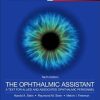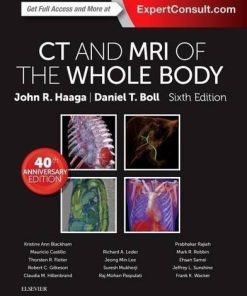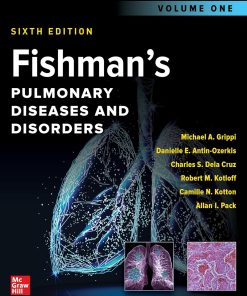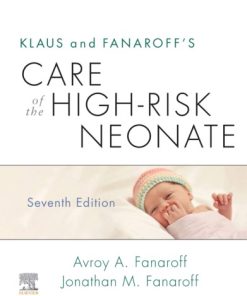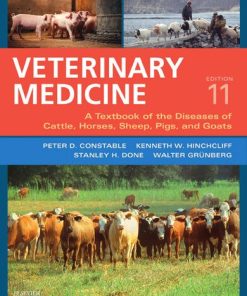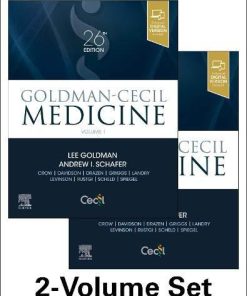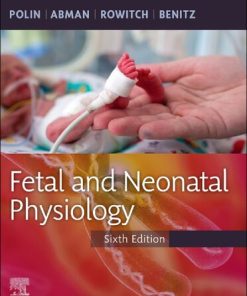Fanaroff and Martins Neonatal Perinatal Medicine 2 Volume Set Diseases of the Fetus and Infant 11th Edition by Avroy Fanaroff, Michele Walsh, Richard Martin 0323567107 9780323567107
$50.00 Original price was: $50.00.$25.00Current price is: $25.00.
Fanaroff and Martins Neonatal Perinatal Medicine 2 Volume Set Diseases of the Fetus and Infant 11th Edition by Avroy Fanaroff, Michele C. Walsh, Richard J. Martin – Ebook PDF Instant Download/DeliveryISBN: 0323567107, 9780323567107
Full download Fanaroff and Martins Neonatal Perinatal Medicine 2 Volume Set Diseases of the Fetus and Infant 11th Edition after payment.

Product details:
ISBN-10 : 0323567107
ISBN-13 : 9780323567107
Author: Avroy Fanaroff, Michele C. Walsh, Richard J. Martin
Fanaroff and Martin’s Neonatal-Perinatal Medicine
Fanaroff and Martins Neonatal Perinatal Medicine 2 Volume Set Diseases of the Fetus and Infant 11th Table of contents:
Part 1 The Field of Neonatal-Perinatal Medicine
1 Growth of Neonatal Perinatal Medicine—A Historical Perspective
Perinatal Pioneers
The High-Risk Fetus and Perinatal Obstetrics
Midwives and Perinatal Care
Neonatal Resuscitation: Tales of Heroism and Desperation
Apgar and the Language of Asphyxia
Foundling Asylums and Infant Care
Saving Infants to Man the Army
An Ingenious Contrivance, the Couveuse, and Premature Baby Stations
Incubators, Baby Shows, and Origins of Neonatal Intensive Care Units
Supportive Care and Oxygen Therapy
Ventilatory Care: “Extended Resuscitation”
Supportive Care: Intravenous Fluid and Blood Transfusions
Tools and Supplies for Neonatal Intensive Care Units
Pediatric Surgery: Not for Rabbits Anymore
Global Neonatal Care
Medical Errors and “Patient Safety” as a New Discipline
Controlled Clinical Trials, Evidence-Based Medicine, and Research Networks
Future of Neonatal Research, Education, and Databases in the Internet Era
Some Famous High-Risk Infants
Acknowledgment
Key Points
References
2 Epidemiology for Neonatologists
Introduction
Common Epidemiologic Concepts
Health Statistics and Data Sources
Birth Data
Fetal Deaths
Infant Deaths
Pregnancy-Related Deaths
Maternal Morbidity
Neonatal Morbidity
Key Points
References
3 Medical Ethics in Neonatal Care
Principles in Medical Ethics
Autonomy
Beneficence
Nonmaleficence
Justice
Key Terms and Concepts
Clinical Applications in Specific Moral Problems
Collaborative, Procedural Framework for End-of-Life Decision Making
Specific Issues in End-of-Life Care
Palliative Care in the Neonatal Intensive Care Unit
Conflict Resolution When Consensus Cannot Be Reached
Ethics of Research in the Neonatal Intensive Care Unit
Ethical Responsibilities of Neonatal Physicians
Acknowledgment
Key Points
References
4 Legal Issues in Neonatal-Perinatal Medicine
Disclaimer
General Legal Principles
Malpractice
Live Birth
Handicapped Newborns
Providing Care Against Parents’ Wishes
Summary
Key Points
References
5 Evaluating and Improving the Quality and Safety of Neonatal Intensive Care
The Case for Improvement
Brief History of Industrial Quality Improvement
Definition and Conceptual Frameworks for Quality
Data and Methods for Quality Improvement
Quality and Safety Applied
Conclusion
Acknowledgments
Key Points
References
6 Simulation and Debriefing in Neonatal-Perinatal Medicine
Introduction
Simulation-Based Training in High-Risk Industries
Simulation-Based Training in Health Care
Simulation-Based Training in Neonatal-Perinatal Medicine
Debriefing Simulated Events
Debriefing Actual Clinical Events
Simulation-Based Assessment
Simulation-Based Research
Simulation as the Basis of Clinical Care
The Future of Simulation in Neonatal-Perinatal Medicine
Key Points
References
7 Practicing Evidence-Based Neonatal-Perinatal Medicine
Asking a Focused Clinical Question
Finding Evidence
Efficient Strategies for Searching for Evidence
Critically Appraising Evidence for Its Validity
Extracting the Data and Expressing the Effect of Treatment
Applying the Results to Patient Care
Promoting Evidence-Based Clinical Practice
Key Points
References
8 Perinatal and Neonatal Care in Developing Countries
Global Initiatives to Reduce Infant Mortality Rate and Neonatal Mortality Rate
Global Burden of Maternal and Neonatal Deaths
Causes of Global Maternal and Neonatal Mortality
Burden of Neonatal Sepsis
Evidence-Based Interventions to Reduce Maternal Mortality Rates, Neonatal Mortality Rates, and Infant Mortality Rates
The Impact of Progress
Strategies to Improve Global Neonatal and Perinatal Outcome
Summary
Acknowledgments
Key Points
References
9 Social and Economic Contributors to Neonatal Outcome in the United States
Epidemiology of Health Disparities in Neonatal and Perinatal Medicine
Social Determinants of Health
Interventions to Reduce Neonatal Health Outcome Disparities
Key Points
References
Part 2 The Fetus
10 Genetic Aspects of Perinatal Disease and Prenatal Diagnosis
Principles of Inheritance
Teratogens
Congenital Anomalies and Ultrasonography
Screening Modalities
Future Directions for Non-Invasive Screening and Diagnosis
Screening for Multifactorial Disorders
Diagnostic Modalities
Technical Advances in Molecular Cytogenetics
Future Directions for Prenatal Diagnostic Testing
Assisted Reproductive Technologies (ART)
Genetic Evaluation and Counseling
Key Points
References
11 Perinatal Ultrasound
Ultrasound Equipment
Fetal Imaging Techniques
Bioeffects and Safety
Ethical Considerations
Applications of Ultrasound Studies
Pregnancy Evaluation
Doppler Ultrasound
Ultrasound-Guided Procedures
Fetal Well-Being Assessment
Fetal Anomalies
Summary
Key Points
References
12 Estimation of Fetal Well-Being
Introduction
Antepartum Fetal Surveillance
Evaluation of the Intrapartum Fetus
Key Points
References
13 Surgical Treatment of the Fetus
Summary
Fetal Access
Anesthetic Considerations
Anomalies Amenable to Fetal Surgery
Conclusion
Key Points
References
14 Adverse Exposures to the Fetus and Neonate
Exposures Not Concurrent With Pregnancy
Maternal Exposures Concurrent With Pregnancy
Pathways of Fetal Exposure
Fetal Pharmacokinetics
Specific Exposures
Conclusions
Key Points
References
15 Intrauterine Growth Restriction
Summary
Definitions and Terminology
The Health Burden of IUGR
Classification of IUGR
Etiology of IUGR
Pathophysiology
Antenatal Screening and Prenatal Management
Prevention
Postnatal Diagnosis of IUGR
Postnatal Management
Long-Term Consequences of IUGR
Conclusions
Key Points
References
16 Developmental Origins of Adult Health and Disease
Fetal Origins of Adult Disease Concept
Postnatal Growth and Nutrition
Mismatch Concept
Placental Abnormalities and Association With Adult Disease
Gestational Diabetes and Long-Term Metabolic Effects on Offspring
Toxins, Endocrine Disrupters, and Micronutrient Metabolism (See Also Chapter 14)
Epigenetics
Translation to Neonatology
Key Points
References
Part 3 Pregnancy Disorders and Their Impact on the Fetus
17 Hypertensive Disorders of Pregnancy
Classification of Hypertensive Disorders of Pregnancy
Epidemiology of Preeclampsia
Clinical Presentation of Preeclampsia
Other Hypertensive Disorders of Pregnancy
Prediction
Prevention
Key Points
References
18 Pregnancy Complicated by Diabetes Mellitus
Gestational Diabetes Mellitus
Key Points
References
19 Obstetric Management of Prematurity
Prematurity
Pathogenesis
Risk Factors
Predicting Preterm Labor
Prevention
Treatment
Summary
Acknowledgments
Key Points
References
20 Fetal Effects of Autoimmune Disease
Placental Transfer: General Remarks
Fetal Thrombocytopenia
Fetal-Neonatal Consequences of Maternal Antinuclear Antibodies
Fetal-Neonatal Consequences of Maternal Antiphospholipid Antibodies
Myasthenia Gravis
Herpes Gestationis
Summary
Key Points
References
21 Obstetric Management of Multiple Gestation and Birth
Biology
Maternal Consequences
Fetal and Neonatal Consequences
Delivery Considerations
Outcome
Summary: Prevention Versus Cure
Key Points
References
22 Post-Term Pregnancy
Risks of Post-Term Pregnancy
Assessment of Fetal Well-Being
Should Labor Be Induced Before 42 Weeks?
How Should Labor Be Induced?
Post-Term Twin Pregnancies
Summary
Key Points
References
23 Immune and Nonimmune Hydrops Fetalis
Immune Hydrops Fetalis
Nonimmune Hydrops Fetalis
Summary
Key Points
References
24 Amniotic Fluid Volume
Amniotic Fluid Dynamics
Measurement of Amniotic Fluid Volume
Normal Volume and the Singleton Pregnancy
Twins and Amniotic Fluid
Abnormalities of Amniotic Fluid Volume and Their Management
Management of Fluid Abnormalities in Multifetal Pregnancies
The Future
Key Points
References
25 Perinatal Infections and Chorioamnionitis
Definitions and Epidemiology
Microbiology
Diagnosis
Pathogenesis
Treatment
Outcomes
Areas for Future Investigation
Key Points
References
26 Placental Pathology
Optimal Use of Pathology Service
Structure, Function, and Pathologic Reaction Patterns
Clinical Correlation
Summary
Key Points
References
Part 4 The Delivery Room
27 Anesthesia for Labor and Delivery
Labor Pain Characteristics and Challenges
Techniques That Modify Pain
Obstetric Nerve Blocks
Neuraxial Blocks
Delivery Modes and Anesthetic Techniques
Key Points
References
28 Physical Examination of the Newborn
Routine Examination
Detailed Neurologic Assessment
Interpretation of the Neurologic Examination
Limitations of the Routine Examination
Health Promotion
Discharge
Key Points
References
29 Birth Injuries
Injuries to Soft Tissues
Injuries to the Head
Injuries to the Neck, Shoulder Girdle, and Chest
Injuries to the Spine and Spinal Cord
Injuries to Intra-Abdominal Organs
Injuries to the Extremities
Trauma to the Genitalia
Injuries Related to Intrapartum Fetal Monitoring
Injuries Related to Trauma During Pregnancy
Key Points
References
30 Congenital Anomalies
General Clinical Approach
Epidemiology and Etiology
Evaluation
Diagnostic Testing and Indications
Genetic Counseling
Educational Resources and Support Organizations
Acknowledgments
Key Points
References
Part 5 Resuscitation of the Newborn
31 Overview and Initial Management of Delivery Room Resuscitation
Fetus
Transition at Birth
Causes of Depression and Asphyxia
Response to Asphyxia
Preparation for Resuscitation
Apgar Score
Umbilical Cord Blood Gases
Elements of a Resuscitation
Key Points
References
32 Role of Positive Pressure Ventilation in Neonatal Resuscitation
Normal Transition and Initial Spontaneous Breathing
Delayed Transition and Need for Respiratory Support
Basics of Positive Pressure Support
Application of Noninvasive Positive Pressure Support
Applying Positive Pressure Support
The First Breaths
Peak Inflation Pressures and Tidal Volumes
Positive End Expiratory Pressure
Inflation Rate and Duration
Gas Flow
Key Points
References
33 Oxygen Therapy in Neonatal Resuscitation
Use of Oxygen in Perinatal Asphyxia and Resuscitation
Room Air versus Pure Oxygen for Resuscitation of the Newborn
Oxygen Supplementation in the Delivery Room in Extremely Low Gestational Age Neonates
Room Air versus 100% Oxygen—or Something Else
Key Points
References
34 Chest Compression, Medications, and Special Problems in Neonatal Resuscitation
Importance of Effective Ventilation
Chest Compressions
Medications
When to Discontinue Resuscitation Efforts
Immediate Care After Establishing Adequate Ventilation and Circulation
Special Problems During Resuscitation
Screening for Congenital Defects
Key Points
References
Part 6 The Physical Environment in Neonatal Care
35 Thermal Environment of the Intensive Care Nursery
Heat Exchange Physics
Thermal Physiology
Temperature Monitoring
Thermal Aspects of the Care Environment
Recommendations for Practice
Key Points
References
36 Optimization of the NICU Environment
Neurobehavioral Maturation
Behavioral/Sleep States and NICU Environment
Sensory Functions and NICU Environment
Circadian Rhythm and NICU Environment
Sensory Functions and Pain
Muscle Tone, Movements, and Reflexes
Sucking and Swallowing
Environment Supporting Growth
Environment Protecting From Infections
Environment Supporting Parent–Infant Interaction
Neurobehavioral Assessment Tools
NICU Design
Health Care Team Perspectives
Conclusion
Key Points
References
Part 7 Provisions for Neonatal Care
37 Biomedical Engineering Aspects of Neonatal Cardiorespiratory Monitoring
Hemodynamic Monitoring
Blood Gas Monitoring
Respiratory Monitoring
Future Directions
Key Points
References
38 Diagnostic Imaging of the Neonate
Introduction
Radiography, Fluoroscopy, and Computed Tomography
Ultrasound
MRI
Scintigraphy
Chest
Heart
Gastrointestinal Tract
Hepatobiliary Tract
Urinary Tract
Adrenal Glands
Brain
Spine
Skeletal
Future Directions
Acknowledgments
Key Points
References
39 Anesthesia in the Neonate
Developmental Challenges of Neonatal Anesthesia
Anesthesia, Neonatal Physiology, and Specific Concerns
Conduct of an Anesthetic
Key Points
References
40 The Late Preterm Infant
Definition
Epidemiology and Trends
Etiology
Pathophysiology
Clinical Outcomes
Hospitalizations and Rehospitalizations After Discharge
Long-Term Outcomes and Societal Costs
Management
Key Points
References
41 Nutrient Requirements/Nutritional Support in Premature Neonate
Growth in the Neonatal Intensive Care Unit
Growth and Neurodevelopmental Outcomes
Nutrient Requirements
Provision of Nutritional Support
Acknowledgment
Key Points
References
42 Support for the Family
Normal Mother–Infant Attachment
Formation of Mother–Infant Attachment
Attachment Challenges With Sick or Premature Infants
Parental Stress
Family Engagement
Parental Mental Health Issues
Discharge Planning
Acknowledgments
Key Points
References
Part 8 Developmental Pharmacology
43 Principles of Drug Use in the Fetus and Neonate
Fetal Drug Disposition
Neonatal Drug Disposition
Key Points
References
44 Principles of Drug Use During Lactation
Passage of Exogenous Compounds From Maternal Blood to Milk
Delivery of Compounds to and Disposition by the Infant
Conclusions Concerning Breastfeeding and Maternal Drug Therapy
Key Points
References
45 Pharmacokinetics in Neonatal Medicine
Drug Disposition Explains Drug Exposure Over Time: Absorption, Distribution, Metabolism, and Excretion
Pharmacokinetic Models Describe Concentration of Drug Over Time
Key Points
References
46 Infants of Substance-Using Mothers
Prenatal and Perinatal Considerations
Neonatal Considerations
Marijuana (Cannabinoids)
Opioids
Benzodiazepines and Barbiturates
Cocaine
Amphetamines
Key Points
References
Part 9 The Immune System
47 Developmental Immunology
Overview of Hematopoiesis
Innate Immunity
Acquired Immunity
Passive Immunity
Evaluation of Host Defenses in Neonates
Key Points
References
48 Postnatal Bacterial Infections
Neonatal Sepsis
Bacterial Infections by Organ System
Specific Pathogens
Acknowledgments
Key Points
References
49 Fungal and Protozoal Infections of the Neonate
Definitions
Microbiology
Pathogenesis and Pathophysiology
Prematurity
Incidence
Outcomes
Risk Factors
Clinical Manifestations
Treatment
Prevention
Conclusions
Antifungal Prophylaxis Summary
Invasive Candida Infection Summary
Aspergillus, Mucormycosis, Malassezia, and Trichosporin Infections in the Neonatal Intensive Care Unit
Other Fungal Infections
Protozoal Infections
Acknowledgment
Key Points
References
50 Viral Infections in the Neonate
Herpesvirus Family
Paramyxoviruses Family
Human Immunodeficiency Virus
Enteroviruses and Parechoviruses
Hepatitis Viruses
Rotavirus
Parvovirus B19
Influenza A and B
Rubella Virus
Rhinovirus
Coronavirus: Severe Acute Respiratory Syndrome and Middle East Respiratory Syndrome
West Nile Virus
Adenovirus
Human Papillomavirus
Emerging Viruses
Acknowledgment
Key Points
References
Part 10 The Central Nervous System
51 Normal and Abnormal Brain Development
Neural Induction and Neurulation
Neuronal Proliferation
Neuronal Migration and Cortical Lamination
Central Nervous System Organization
Brain Vascular Development
Abnormal Brain Development and Disorders
Key Points
References
52 White Matter Damage and Encephalopathy of Prematurity
Neuropathology of White Matter Injury
Models of Encephalopathy of Prematurity: Implications for Pathogenesis
Neuroimaging of White Matter Injury
Impairment of Brain Growth and Long-Term Development
Key Points
References
53 Intracranial Hemorrhage and Vascular Lesions in the Neonate
Germinal Matrix Hemorrhage–Intraventricular Hemorrhage
Cerebral Artery Infarction
Key Points
References
54 Hypoxic–Ischemic Encephalopathy
Definitions
Pathophysiology
Perinatal Hypoxic–Ischemic Brain Damage
Neuropathology
Assessment Tools
Neuroimaging
Chemical Biomarkers
Management
Resuscitation
Systemic Management
Brain-Oriented Management
Specific Neuroprotective Strategies
Prognostic Factors
Association Between Hypoxic–Ischemic Encephalopathy and Less Severe Neurodisability
Acknowledgment
Key Points
References
55 Seizures in Neonates
Pathophysiology of Newborn Seizures—Unique Maturational Features Increasing the Likelihood of Seizures in the Newborn
Biochemical and Physiologic Consequences of Seizures in the Immature Brain—Implications for the Clinician
Classification of Seizures in the Newborn
Seizure Etiology
Diagnosis
Prognosis
Management
Key Points
References
56 Hypotonia and Neuromuscular Disease in the Neonate
Diagnosis
Neonatal Neuromuscular Disorders
Spinal Muscular Atrophies
Hereditary Motor and Sensory Neuropathies
Hereditary Sensory and Autonomic Neuropathies
Neuromuscular Junction Disorders
Congenital Muscular Dystrophy
Congenital Myotonic Dystrophy
Other Muscular Dystrophies
Congenital Myopathies
Metabolic and Multisystem Disorders
Acknowledgments
Key Points
References
57 Intracranial and Calvarial Disorders
Summary
Examination of the Head
The Neonate
Hydrocephalus
Hydranencephaly
Craniosynostosis
Conclusion
Key Points
References
58 Spinal Dysraphisms
Summary
Introduction
Embryology
Pathology
Prenatal Screening and Prevention
Cutaneous Stigmata
Imaging
Overall Management
Surgical Treatment
Conclusion
Key Points
References
59 Hearing Loss in the Newborn Infant
Background
Normal Hearing and Hearing Loss
Tests for Hearing Loss
Early Intervention Services
Etiology of Hearing Loss
Risk Factors
Medical Workup for Hearing Loss and Care Coordination
Middle Ear Disease
Communication Options
Audiologic Devices
Continued Surveillance
Stress and Impact on the Family
Key Points
References
60 Early Childhood Neurodevelopmental Outcomes of High-Risk Neonates
Medical Problems
Neurodevelopmental Outcome
Methodologic Considerations in Neurodevelopmental Outcome Studies
School-Age Outcome
Young Adult Outcomes
Children Born at the Threshold of Viability
Early Intervention
Key Points
References
61 The Role of Neonatal Neuroimaging in Predicting Neurodevelopmental Outcomes of Preterm Neonates
Cranial Ultrasound
Conventional (Qualitative) Magnetic Resonance Imaging
Areas of the Brain and Findings of Interest
Future Developments
Key Points
References
Volume 2
Part 11 The Respiratory System
62 Lung Development and Maturation
A Brief History
Lung Structural Development
Fetal Lung Fluid
Pulmonary Hypoplasia
Other Disorders of Lung Development
Alveolar Macrophages
Surfactant Metabolism
Physiologic Effects of Surfactant in the Preterm Lung
Lung Maturation
Key Points
References
63 Assessment of Neonatal Pulmonary Function
Clinical Observations
Cardiovascular Assessment
Respiratory Function
Clinical Applications
Key Points
References
64 Respiratory Distress Syndrome in the Neonate
Incidence
Pathophysiology
Heritability of Respiratory Distress Syndrome
Prevention: Pharmacologic Acceleration of Pulmonary Maturation
Clinical Features
Radiographic Findings
Treatment
Key Points
References
65 Assisted Ventilation of the Neonate and Its Complications
Continuous Positive Airway Pressure and Noninvasive Ventilation
Indications for Assisted Ventilation
General Principles of Assisted Ventilation
Classification of Mechanical Ventilators
Suggested Ventilatory Management Guidelines
Monitoring of Ventilated Infants
Complications of Assisted Ventilation
Key Points
References
66 Neonatal Respiratory Disorders
Developmental Diseases
Acquired Neonatal Pulmonary Diseases
Rib Cage Abnormalities
Phrenic Nerve Injury
Key Points
References
67 Neonatal Apnea and the Foundation of Respiratory Control
Fetal Breathing
Postnatal Development of Respiratory Control
Neonatal Apnea, Bradycardia, and Hypoxemia
Brief Resolved Unexplained Events (BRUE) (Formerly Known as Apparent Life-Threatening Events or ALTE)
Key Points
References
68 Upper Airway Lesions in the Neonate
Nasal and Nasopharyngeal Lesions
Oral and Oropharyngeal Lesions
Laryngeal Lesions
Conclusion
Key Points
References
69 Bronchopulmonary Dysplasia in the Neonate
Epidemiology of BPD
Pathogenesis
Pathology
Clinical Presentation
Prediction of Bronchopulmonary Dysplasia
Pulmonary Function
Prevention of BPD
Management of Established BPD
Infant Stimulation
Parental Support
Outcome
Key Points
References
70 Therapy for Cardiorespiratory Failure in the Neonate
Extracorporeal Membrane Oxygenation
ECMO and Hypothermia Therapy
Nitric Oxide Therapy
Key Points
References
Part 12 The Cardiovascular System
71 Cardiac Embryology
Introduction
Overview of Normal Heart Development
Scientific Basis of Cardiogenesis
Key Points
References
72 Pulmonary Vascular Development
Fetal Pulmonary Vascular Development
Pulmonary Vascular Transition
Vasoactive Mediators of the Pulmonary Vascular Transition
Abnormalities of Pulmonary Vascular Development
Clinical Therapy of PPHN
Outcome and Follow-Up
Key Points
References
73 Prenatal Diagnosis of Congenital Heart Disease
Introduction
Historical Perspective
Overview of Fetal Circulation and Cardiac Adaptation at Birth
Indications for Fetal Echocardiogram
Fetal Pathology
Parental Counseling after Fetal Diagnosis of Congenital Heart Disease
Impact of Prenatal Diagnosis
Limitations of Fetal Echocardiogram
Fetal Therapies
Novel Approaches to Prenatal Diagnosis of Congenital Heart Disease
Summary
Key Points
References
74 Patent Ductus Arteriosus
Pathogenesis
Pathophysiology
Clinical Presentation
Diagnostic Evaluation
Management
Key Points
References
75 Congenital Defects of the Cardiovascular System
Summary
Cyanotic Heart Defects: Mixing-Dependent
Cyanotic Heart Defects: Restricted Pulmonary Blood Flow
Cyanotic Heart Defects: Complete Mixing
Cyanotic Heart Defects: Variable Physiology
Obstructive Heart Defects
Shunting Lesions
Acknowledgments
Key Points
References
76 Cardiovascular Problems of the Neonate
Cardiac Malposition and Abnormalities of Abdominal Situs
Arteriovenous Malformations
Myocardial Diseases: Cardiomyopathy and Myocarditis
Pericardial Diseases
Cardiac Tumors
Vascular Rings and Slings
Neonatal Marfan Syndrome
The Premature Baby With Congenital Heart Disease
Palliative Care
Acknowledgments
Key Points
References
77 Disorders of Cardiac Rhythm and Conduction in Newborns
Normal Sinus Rhythm and Sinus Node Dysfunction
Sinus Arrhythmia
Tachyarrhythmias
Ventricular Arrhythmias
Atrioventricular Conduction Disturbances
Key Points
References
78 Neonatal Management of Congenital Heart Disease
Introduction
Cyanotic Congenital Heart Conditions
Acyanotic Congenital Heart Conditions
Miscellaneous Procedures
Medical Management
What the Future Holds
Key Points
References
Part 13 The Blood and Hematopoietic System
79 Hematologic and Oncologic Problems in the Fetus and Neonate
Human Hematopoietic Development
Red Blood Cells
Red Blood Cell Disorders
White Blood Cells
The Hemostatic System
Neonatal Platelet Disorders
Neonatal Coagulation Disorders
Neonatal Thrombotic Disorders
Neoplasms in the Neonate
Acknowledgments
Key Points
References
80 Blood Component Therapy for the Neonate
Special Considerations for Transfusion Therapy in the Neonate
Risks of Transfusion Therapy
Donor-Specific Units
Blood Products
Factor Concentrates
Special Topics in Neonatal Transfusion
Future Directions
Key Points
References
Part 14 The Gastrointestinal Tract
81 Development of the Neonatal Gastrointestinal Tract
The Beginning
Esophagus
Stomach
Duodenum, Pancreas, and Biliary System
Small Intestine
Colon, Rectum, and Anus
Acknowledgments
Key Points
References
82 Gastrointestinal Reflux and Motility in the Neonate
Definitions
Physiology of Gastroesophageal Reflux
Gastroesophageal Reflux Disease
Summary
Key Points
References
83 Disorders of Digestion in the Neonate
Disorders of Carbohydrate Absorption
Fat Malabsorption
Disorders of Protein Absorption
Disorders of Electrolyte Absorption
Disordered Villous Architecture
Acrodermatitis Enteropathica
Trichohepatoenteric Syndrome (Phenotypic or Syndromic Diarrhea)
Autoimmune Enteropathy
Infectious Enteropathy
Allergic Colitis or Eosinophilic Proctocolitis
Food Protein-Induced Enterocolitis Syndrome
Other Causes of Infantile Diarrhea
Key Points
References
84 Selected Gastrointestinal Anomalies in the Neonate
Thoracic Anomalies
Esophageal Duplications
Congenital Diaphragmatic Hernia
Abdominal Wall Defects
Gastric Volvulus
Microgastria
Gastric Perforation
Lactobezoars
Pyloric Atresia
Hypertrophic Pyloric Stenosis
Duodenal Atresia and Stenosis
Gastrointestinal Duplications
Malrotation and Midgut Volvulus
Meconium Syndromes
Jejunoileal Atresia and Stenosis
Hirschsprung Disease
Anorectal Anomalies
Acknowledgments
Key Points
References
85 Neonatal Necrotizing Enterocolitis
Summary
Definition of NEC
Epidemiology
Clinical Features
Treatment
Outcomes
Pathophysiology of Necrotizing Enterocolitis
Preventive Strategies
Key Points
References
Part 15 Metabolic and Endocrine Disorders
86 Disorders of Carbohydrate Metabolism in the Neonate
Placental Transport of Nutrients: Maternal–Fetal Relationship
Fetal Hormones Mediating Growth
Fetal Glucose Metabolism
Glucose Metabolism After Birth
Hypoglycemia
Hyperglycemia
Diabetes Mellitus in the Newborn
Key Points
References
87 Disorders of Calcium, Phosphorus, and Magnesium Metabolism in the Neonate
Calcium, Phosphorus, and Magnesium Physiology
Hormonal Regulation of Mineral Metabolism
Bone Development
Clinical Conditions Associated With Calcium Disturbances
Clinical Conditions Associated With Magnesium Disturbances
Osteopenia of Prematurity
Acknowledgments
Key Points
References
88 Thyroid Disorders in the Neonate
Physiologic Action of Thyroid Hormones
Synthesis, Release, Transport, and Use of Thyroid Hormones
Laboratory and Imaging Tests Used in the Diagnosis of Thyroid Disease in Infancy and Childhood
Proteins That Bind to Thyroid Hormones
Thyroid Imaging
Congenital Hypothyroidism
Defects in TSH or Thyroid Hormone Action
Diagnosis of Congenital Hypothyroidism
Transient Disorders of Thyroid Function
Neonatal Graves Disease
Familial Abnormalities of Thyroxine-Binding Proteins
Key Points
References
89 Disorders of Sex Development
Fetal Sexual Determination and Differentiation
A Clinical Approach to the Infant With Suspected Disorder of Sex Development
Disorders of Sex Development
Acknowledgments
Key Points
Resources for Families
References
90 Inborn Errors of Metabolism
Common Misconceptions
Prospective Approaches
The Abnormal Newborn Infant: Clinical Phenotypes
The Abnormal Newborn Infant: Laboratory Phenotypes
Treatment
Conclusion
Key Points
References
Part 16 Neonatal Jaundice and Liver Disease
91 Neonatal Jaundice and Liver Diseases
Bilirubin Metabolism
“Conjugated” versus “Direct” Bilirubin
Equilibrium Between Bilirubin Production and Elimination Processes—The Major Determinant of TB Levels
Genetic Control of Bilirubin Production
Genetic Control of Uptake of Bilirubin into the Hepatocyte
Co-expression of Genes Modulating the Risk of Neonatal Hyperbilirubinemia
Bilirubin-Induced Neurologic Dysfunction (BIND)
Newer Methods of Diagnosis
Hyperbilirubinemia in Resource-Limited Countries
Conjugated Hyperbilirubinemia
Key Points
References
Part 17 The Kidney and Urinary Tract
92 Fluid, Electrolytes, and Acid-Base Homeostasis
Fluid and Electrolyte Management
Acid–Base Management
Key Points
References
93 The Kidney and Urinary Tract of the Neonate
Kidney and Urinary Tract Development
Evaluation of the Neonate With Renal Disease
Clinical Problems
Congenital Anomalies of Kidneys and Urinary Tract
Tumors of the Kidney
Key Points
References
Part 18 The Skin
94 The Skin of the Neonate
The Structural Biology of Fetal and Neonatal Skin
Disorders and Diseases of Fetal and Neonatal Skin
Principles of Newborn Skin Care
Key Points
References
Part 19 The Eye
95 Examination and Common Problems in the Neonatal Eye
Neonatal Eye Examination
Orbital Abnormalities
Hyperthyroid Exophthalmos
Eyelid Abnormalities
Eyelid Lesions
Eyelash Abnormalities
Lacrimal Abnormalities
Globe Abnormalities
Corneal Abnormalities
Iris Abnormalities
Lens Abnormalities
Retina and Vitreus Diseases
Congenital Disc Anomalies
Intraocular Tumors
Neuromuscular Abnormalities
Eye Findings in Chromosomal Syndromes
Eye Findings in Craniofacial Syndromes
Eye Findings in Neurocutaneous Disorders (Phakomatoses)
Ocular Trauma
Neonatal Ocular Infections
Ocular Tumors in Infants
Ocular Manifestations of Maternal Substance Abuse
Key Points
References
96 Retinopathy of Prematurity
Introduction
Incidence
Pathogenesis
Classification
Clinical Course
Therapy
Candidate Interventions for Prevention and Treatment
Recommendations for Examination Schedule
Acknowledgment
Key Points
References
Part 20 Neonatal Orthopedics
97 Musculoskeletal Disorders in Neonates
Normal Embryology
In Utero Positioning
Trauma
Key Points
References
98 Bone and Joint Infections in Neonates
Osteomyelitis
Septic Arthritis
Acknowledgment
Key Points
References
99 Congenital Abnormalities of the Upper and Lower Extremities and Spine
Upper Extremities
Spine
Lower Extremities
Syndromes
Key Points
References
Appendices
Appendix A Therapeutic Agents
Appendix B Tables of Normal Values
Physiologic Parameters
Growth Charts
Chemistry Values
Hormone Levels
Cerebrospinal Fluid
People also search for Fanaroff and Martins Neonatal Perinatal Medicine 2 Volume Set Diseases of the Fetus and Infant 11th:
fanaroff and martin’s neonatal perinatal medicine 12th edition
fanaroff and martin’s neonatal perinatal medicine pdf
fanaroff and martin’s neonatal perinatal medicine citation
fanaroff and martin’s neonatal perinatal medicine 11th edition
fanaroff and martin’s neonatal perinatal medicine 2024
Tags: Fanaroff, Martins, Neonatal Perinatal Medicine, Diseases, the Fetus, Infant, Avroy Fanaroff
You may also like…
Uncategorized
Principles and Practice of Sleep Medicine – 2 Volume Set 7th Edition Meir H. Kryger Md. Frcpc
Medicine & Health Science
Auerbachu2019s Wilderness Medicine, 2-Volume Set 7th Edition
Uncategorized
Medicine - Clinical Medicine
Fishman’s Pulmonary Diseases and Disorders, 2-Volume Set, Sixth Edition Michael A. Grippi
Medicine - Veterinary Medicine
Medicine & Health Science
Goldman-Cecil Medicine, 2-Volume Set (Cecil Textbook of Medicine) 26th
Medicine - Pediatrics
Fetal and Neonatal Physiology 2-Volume Set 6th Edition Richard A. Polin



